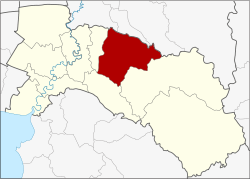Phanom Sarakham District
Phanom Sarakham District (Thai: พนมสารคาม, pronounced [pʰā.nōm sǎː.rā.kʰāːm]) is a district (amphoe) in the central part of Chachoengsao Province, central Thailand.
Phanom Sarakham พนมสารคาม | |
|---|---|
 District location in Chachoengsao Province | |
| Coordinates: 13°44′41″N 101°20′50″E | |
| Country | Thailand |
| Province | Chachoengsao |
| Seat | Phanom Sarakham |
| Area | |
| • Total | 550.0 km2 (212.4 sq mi) |
| Population (2017) | |
| • Total | 82,380 |
| • Density | 149.78/km2 (387.9/sq mi) |
| Time zone | UTC+7 (ICT) |
| Postal code | 24120 |
| Geocode | 2406 |
History
Mueang Phanom Sarakham was a city of Ayutthaya Kingdom, contemporaneous with Mueang Phanat Nikhom and Sanam Chai Khet. It became Phanom Sarakham District in 1894. In 1937 the district office was moved from Ban Mueang Mai, Phanom Sarakham Subdistrict to Ban Nong Ri, Mueang Kao Subdistrict.[1]
Geography
Neighbouring districts are (from the east clockwise): Sanam Chai Khet, Plaeng Yao, Ratchasan of Chachoengsao Province; Si Mahosot and Si Maha Phot of Prachinburi Province.
The important water resource is the Khlong Tha Lat.
Economy
Ko Khanun Subdistrict has become a centre for recycling potentially hazardous electronic waste (e-waste), despite a June 2018 ban on imports of foreign e-waste to Thailand. China banned the import of foreign e-waste in 2018 also. Since the e-waste ban, 28 new recycling factories, most dealing with e-waste, have started in Chachoengsao Province, where Ko Khanun is located. In 2019, 14 businesses in Chachoengsao were granted licenses to process electronic waste, six of them in Ko Khanun in Phanom Sarakham District. An official of the Basel Action Network, which campaigns against dumping waste in poor countries, said, "E-waste has to go somewhere, and the Chinese are simply moving their entire operations to Southeast Asia. The only way to make money is to get huge volume with cheap, illegal labour and pollute the hell out of the environment," he added.[2]
Administration
Central administration
The district is divided into eight sub-districts (tambons), which are further subdivided into 87 administrative villages (mubans).
| No. | Name | Thai | Villages | Pop.[3] |
|---|---|---|---|---|
| 1. | Ko Khanun | เกาะขนุน | 15 | 15,999 |
| 2. | Ban Song | บ้านซ่อง | 14 | 10,160 |
| 3. | Phanom Sarakham | พนมสารคาม | 3 | 9,989 |
| 4. | Mueang Kao | เมืองเก่า | 7 | 2,936 |
| 5. | Nong Yao | หนองยาว | 12 | 9,256 |
| 6. | Tha Than | ท่าถ่าน | 7 | 8,223 |
| 7. | Nong Nae | หนองแหน | 15 | 9,919 |
| 8. | Khao Hin Son | เขาหินซ้อน | 14 | 15,898 |
Local administration
There are five sub-district municipalities (thesaban tambons) in the district:
- Ban Song (Thai: เทศบาลตำบลบ้านซ่อง) consisting of sub-district Ban Song.
- Tha Than (Thai: เทศบาลตำบลท่าถ่าน) consisting of sub-district Tha Than.
- Ko Khanun (Thai: เทศบาลตำบลเกาะขนุน) consisting of parts of sub-district Ko Khanun.
- Khao Hin Son (Thai: เทศบาลตำบลเขาหินซ้อน) consisting of parts of sub-district Khao Hin Son.
- Phanom Sarakham (Thai: เทศบาลตำบลพนมสารคาม) consisting of parts of sub-district Phanom Sarakham.
There are six sub-district administrative organizations (SAO) in the district:
- Ko Khanun (Thai: องค์การบริหารส่วนตำบลเกาะขนุน) consisting of parts of sub-district Ko Khanun.
- Phanom Sarakham (Thai: องค์การบริหารส่วนตำบลพนมสารคาม) consisting of parts of sub-district Phanom Sarakham.
- Mueang Kao (Thai: องค์การบริหารส่วนตำบลเมืองเก่า) consisting of sub-district Mueang Kao.
- Nong Yao (Thai: องค์การบริหารส่วนตำบลหนองยาว) consisting of sub-district Nong Yao.
- Nong Nae (Thai: องค์การบริหารส่วนตำบลหนองแหน) consisting of sub-district Nong Nae.
- Khao Hin Son (Thai: องค์การบริหารส่วนตำบลเขาหินซ้อน) consisting of parts of sub-district Khao Hin Son.
References
- ประกาศกระทรวงมหาดไทย เรื่อง ย้ายที่ว่าการอำเภอพนมสารคาม จังหวัดฉะเชิงเทรา (PDF). Royal Gazette (in Thai). 54 (0 ง): 420. 1937-06-07.
- Beech, Hannah; Jirenuwat, Ryn (8 December 2019). "Recycled laptops triggering toxic fumes in Thailand". New York Times. Retrieved 11 December 2019 – via The Independent.
- "Population statistics 2013" (in Thai). Department of Provincial Administration. Retrieved 2018-04-04.